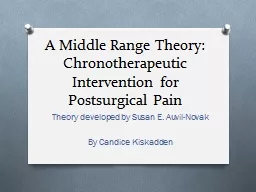

Chronotherapeutic Intervention for Postsurgical Pain Theory developed by Susan E Auvil Novak By Candice Kiskadden Overview Objectives Discuss the theory of Chronotherapeutic Intervention for postsurgical pain CIPP ID: 370320
Download Presentation The PPT/PDF document "A Middle Range Theory:" is the property of its rightful owner. Permission is granted to download and print the materials on this web site for personal, non-commercial use only, and to display it on your personal computer provided you do not modify the materials and that you retain all copyright notices contained in the materials. By downloading content from our website, you accept the terms of this agreement.
Slide1
A Middle Range Theory: Chronotherapeutic Intervention for Postsurgical Pain
Theory developed by Susan E.
Auvil
-Novak
By Candice KiskaddenSlide2
Overview ObjectivesDiscuss the theory of
Chronotherapeutic
Intervention for postsurgical pain (CIPP)
Describe purpose and major concepts of CIPP
List contexts for use of the CIPP theory
Discuss nursing implications of CIPP
Characterize the evidence of empirical testing of CIPP
Outline current research articles using CIPP
Communicate application to author’s practiceSlide3
Theory of Chronotherapeutic Intervention for Postsurgical Pain
CIPP
theory
states pain management is time dependent
“
C
hronotherapeutic
” approaches to pain
Derived from theory, literature review, and studies
Used three separate studies
Analgesic utilization is a feedback loop for pain receptionSlide4
Who is Susan E. Auvil-Novak?
Authored four publications related to nursing
Publication focus was on time aspects
Susan E.
Auvil
-Novak,
Ph.D
, RNSlide5
Analysis and Evaluation CIPP TheorySlide6
Purpose and Major ConceptsPrescriptive Mid-range Nursing Theory
Focused on postoperative pain perception
Pain is chronologically rhythmic
Different pain interventions needed at different levels through cycle
Maximize pain control and minimize adverse effectsSlide7
Context for UseTheory has evidenced-based practice references to past studies
Clinical evidence supports theory of CIPP pharmacologic administration
Can be applied to different types of pain stimuli
Uses model of Individual Biologic Time Structure
Use of CIPP pain management enhances postoperative
outcomes
Can be used for populations unable to verbally communicate: children, neonatesSlide8
Nursing ImplicationsRecent studies support congruency with CIPP Theory
Patient controlled analgesics currently utilized postoperatively
Theory is socially relevant and can be applied transculturally
Increases the nursing evidence-based practice for pain control
Heathcare
professionals can provide better pain control with less adverse effectsSlide9
Evidence of Empirical TestingEmpirical validation
of gynecologic oncology patients
C
ompounding evidence supported the theory in three separate studies
Testing has proved the theory to be accurate and valid
CIPP has been cited in many other scholarly publicationsSlide10
Research Utilizing CIPPHenly, S. J.,
Kallas
, K. D.,
Klatt
, C. M., & Swenson, K. K. (2003). The notion of time in symptom experiences. Nursing Research, 52(6), 410-417.
Sherwood, G. D., McNeill, J. A.,
Starck
, P. L., &
Disnard, G. (2003). Changing acute pain management outcomes in surgical patients. AORN Journal, 77(2), 374-395. Slide11
Henly, Kallas, Klatt, & Swenson
Appropriately uses CIPP Theory to build new SET theory
Uses theory to build on nursing practice
Uses CIPP theory as empirical study to illustrate critical points
Does not continue to develop CIPP theory
Relevant to current evidence-based nursing practicesSlide12
Sherwood, McNeill, Starck, & Disnard
Appropriately uses CIPP theory to increase research knowledge
Supports hypothesis of postoperative pain management
Contributes to
chronotherapeutic
approach of pain assessment
Contends that CIPP theory enhances postoperative outcomes and precipitate recoverySlide13
Practice ApplicationNo direct application
to Operating Room
nursing
Preoperative assessment can include CIPP for greater pain management
Effective for immediately postoperative
OR nurses and CRNAs can influence prescriber for order of CIPPSlide14
References